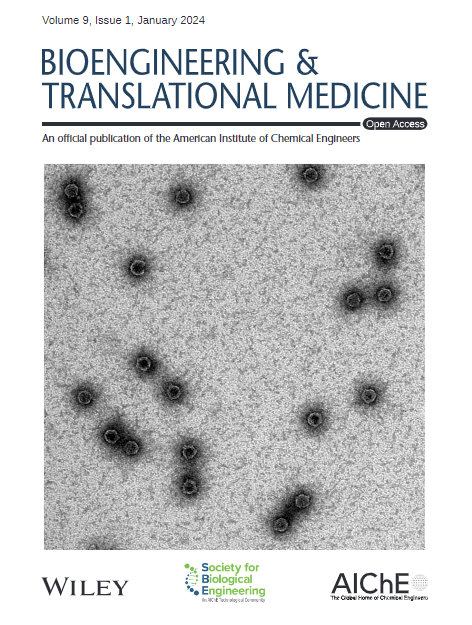Revolutionizing nephrocalcinosis treatment: IL‐10 engineered macrophages as a novel therapeutic approach
IF 6.1
2区 医学
Q1 ENGINEERING, BIOMEDICAL
引用次数: 0
Abstract
Nephrocalcinosis provides a nidus for stone formation and is strongly linked to renal injury and chronic kidney disease. Although the crucial role of macrophages in the formation and progression of calcium oxalate (CaOx) crystals has long been widely recognized, finding effective immunotherapies for nephrocalcinosis remains a challenge. In this study, we described an innovative macrophage‐based method that delivers interleukin‐10 (IL‐10) into the kidney, reduces the deposition of CaOx crystals, and alleviates renal injury in a mouse model of glyoxylate‐induced CaOx. Compared with recombinant IL‐10 direct injection, the macrophage‐based method has the advantages of biocompatibility and sustaining action. We found that the transplantation of engineered macrophages via the tail vein significantly reduced the volume of crystals in the kidney, thereby alleviating the kidney injury caused by crystal. In mechanistic studies, IL‐10‐secreting macrophages inhibited crystal formation and promoted crystal clearance by promoting macrophage M2 polarization, exerting a protective effect on renal tissue. Our data suggest that macrophage‐based delivery of IL‐10 to the kidney can be a potential treatment method for nephrocalcinosis.革命性的肾钙化症治疗:IL - 10工程巨噬细胞作为一种新的治疗方法
肾钙质沉着症是结石形成的温床,与肾损伤和慢性肾脏疾病密切相关。虽然巨噬细胞在草酸钙(CaOx)晶体形成和进展中的关键作用早已被广泛认识,但寻找有效的肾钙化症免疫疗法仍然是一个挑战。在这项研究中,我们描述了一种基于巨噬细胞的创新方法,该方法将白细胞介素- 10 (IL - 10)递送到肾脏,减少CaOx晶体的沉积,并减轻乙醛酸盐诱导CaOx小鼠模型的肾脏损伤。与直接注射重组IL - 10相比,基于巨噬细胞的方法具有生物相容性和持续作用的优势。我们发现工程巨噬细胞经尾静脉移植可显著减少肾脏内晶体的体积,从而减轻晶体对肾脏的损伤。在机制研究中,分泌IL - 10的巨噬细胞通过促进巨噬细胞M2极化抑制晶体形成,促进晶体清除,对肾组织起到保护作用。我们的数据表明,巨噬细胞向肾脏输送IL - 10可能是肾钙化症的一种潜在治疗方法。
本文章由计算机程序翻译,如有差异,请以英文原文为准。
求助全文
约1分钟内获得全文
求助全文
来源期刊

Bioengineering & Translational Medicine
Pharmacology, Toxicology and Pharmaceutics-Pharmaceutical Science
CiteScore
8.40
自引率
4.10%
发文量
150
审稿时长
12 weeks
期刊介绍:
Bioengineering & Translational Medicine, an official, peer-reviewed online open-access journal of the American Institute of Chemical Engineers (AIChE) and the Society for Biological Engineering (SBE), focuses on how chemical and biological engineering approaches drive innovative technologies and solutions that impact clinical practice and commercial healthcare products.
 求助内容:
求助内容: 应助结果提醒方式:
应助结果提醒方式:


